Printable guide for how to prep your home for a hurricane (inside & out) covers everything you’ll need to do before, during, & after a storm.
How to Get Your Home Ready For A Hurricane
This post is full of handy tips and reminders to help you get your home ready for a hurricane, inside and outside, or even the next big storm.
And, I’ve got answers to common questions and answers people have about what to do before, during, and after a hurricane.
If you want a shopping list of everything to stock up on before a big hurricane or winter storm hits, check out Supplies & Food To Stock Up On Before A Hurricane.
This post can help you get ready anytime you think you’ll be losing power for long periods, stuck in your home for a few days, or even just unable to get to grocery stores and gas stations after an emergency weather event.
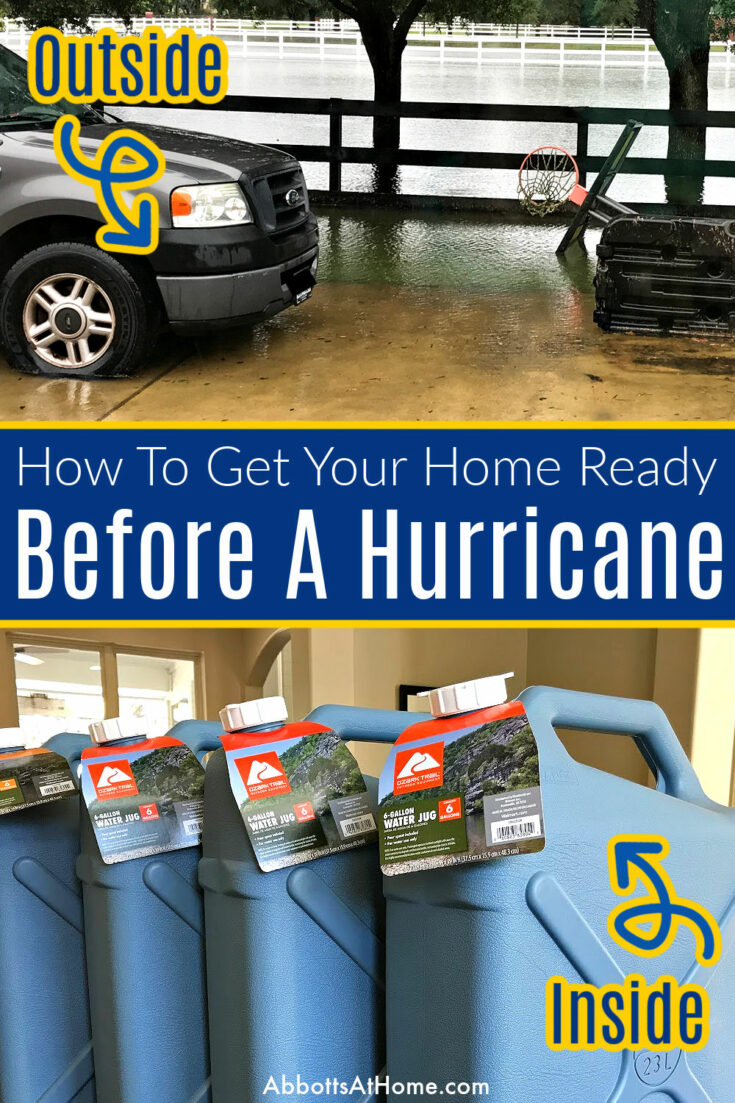
I wanted to share these hurricane prep tips with as many people as possible after going through the craziness and unpredictability of Hurricane Harvey.
You can read a little about our Harvey story and see the pictures on my Cleaning Up Flood Damage post.
Please note, some of these tips may be specific to the United States. Be sure to follow the safety tips in your country.
When Is Hurricane Season in the US?
Hurricane Season for the Atlantic Ocean, Caribbean Sea, and Gulf of Mexico begins June 1st and ends November 30th.
The Eastern Pacific Hurricane Season runs from May 15th to November 30th. But most Hurricanes occur between August and October on both sides of the United States.
Table of contents
- How to Get Your Home Ready For A Hurricane
- Common Hurricane Related Questions And Answers
- How Can You Keep Your House Safe During A Hurricane?
- Where Is The Best Place To Stay Inside Your Home During A Hurricane?
- Tips For Staying Safe Near Flooded Roads and Buildings
- Tips For Safe Evacuation From a Hurricane
Common Hurricane Related Questions And Answers
Do You Lose Water During A Hurricane?
Water supplies can be cut off or contaminated during a hurricane. You should always stock up on water before a hurricane just in case.
We have well water here. Whenever we lose power for long periods, we lose water too, since the pump that pulls the water out of the ground runs on electricity.
Be sure to have 1 gallon of clean drinking water per person, per day before a storm. We lost power for most of 5 days. But some homes lost power for even longer.
If you have to stay in your home during this time, try to have a 7 to 14 day supply of water available for each person in a house.
That daily water supply DOESN’T include water to flush toilets or bathe.
The 1 gallon of water per person, per day rule only covers drinking water, hand washing, food washing, and light requirements for cooking food.
Check out How to Store Water for an Emergency for more info about making an emergency water supply. For more info on the best food supplies for a hurricane, check out Supplies & Food To Stock Up On Before A Hurricane.
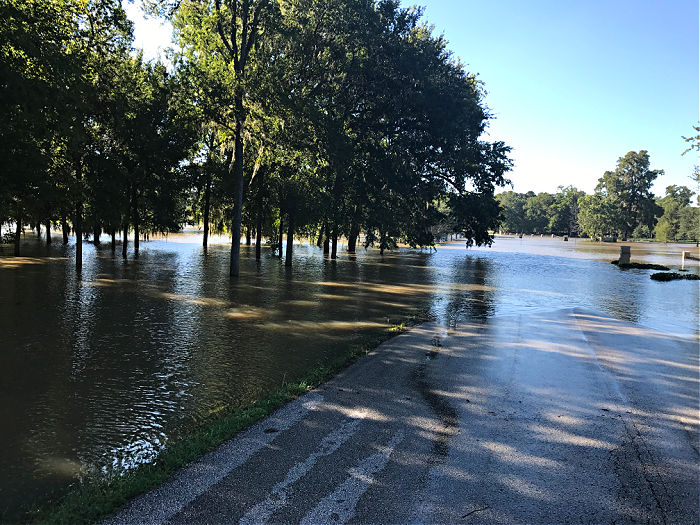
Water Storage for Emergencies Video
Watch this video for a step by step guide to getting your emergency water supply ready.
Should You Fill Your Bathtub Before A Hurricane?
Yes, you should fill every bathtub in your house before a hurricane, severe storm, or severe winter storm hits.
That bathtub water can be used to flush your toilet if the water supply is cut off. A standard bathtub can hold 42 gallons of water, if full.
Newer toilets usually require 1 1/2 to 4 gallons of water to flush them. That means 1 bathtub full of water might only give you 10 flushes on toilets that need 4 gallons.
So, plan ahead. And only flush the toilet during a water cut WHEN NECESSARY.
How to Flush a Toilet Without Running Water?
If you don’t have running water, you can flush the toilet by pouring water directly into the toilet tank. You’ll need enough to fill the tank as high as it normally is when the water is running.
If you need to have water to flush toilets, the tank will need between 1 1/2 and 4 gallons per flush. Some older toilets might even require up to 7 gallons per flush. So try to only flush when necessary, if you know what I mean.
RECOMMENDED: 50 Surprising Pros And Cons About Moving To Houston, Texas (A Few Are Shocking)
Why Do You Need Bleach In A Hurricane?
According to the FDA, if you can’t boil contaminated tap water, you can use bleach to disinfect it. Bleach will only kill SOME of the organisms in the water.
But, if you have no other source of water, that’s better than nothing.
To clean contaminated tap water, first filter cloudy water through clean cloths. Once the water looks clean, you can use 1/8th teaspoon of unscented household liquid bleach (5.25% concentration) per 1 gallon of water.
Stir the bleach into the water, then let that sit for 30 minutes before drinking or using the water.
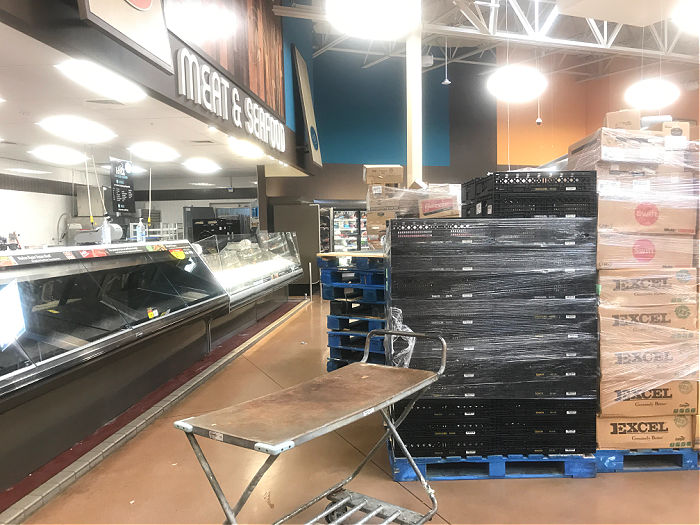
How Can You Keep Your House Safe During A Hurricane?
How To Prepare Your House For A Hurricane Outside
You’ll generally know 3 to 5 days before hand if a hurricane will make landfall near you. Here’s a checklist of things you can do to get the outside of your home ready for a hurricane.
- Clean the gutters. Blocked gutters can cause large amounts of rain from a hurricane to backup under your shingles or into other small openings around the gutters. That water can enter your home, causing damage.
- Clear any grass and materials away from pop-up drains.
- Clear mulch and dirt away from the foundation. Building codes vary in each area. But I would have at least 4 – 6 inches clear below the weep holes in brick or 4 – 6 inches below any other type of siding.
- Make sure that the ground slopes away from the home. After years of plant debris build up and adding mulch, a slope causing drainage towards your house can build up in flower beds or yards. Grab a rake or shovel and slope that soil away from the home, or at least flatten it.
- Caulk any questionable spots around outside window and door trim or soffits.
- Use towels under the inside of doors if the wind is able to blow water under them.
- Have a full tank of gas in each car. Cars need to be ready for evacuations. And, they’re great for charging devices or letting kids watch a little car TV in air conditioning during long power outages.
- If you are close enough to the coast, boarding up windows and doors is also necessary. Hurricane shutters or 5/8″ plywood should be used.
- Again, if you’re close enough to the coast to get high winds, board up or reinforce the garage door too. You don’t want it blowing open.
- Take all of your yard furniture, pots, and toys inside the garage or to another secure place. Large items that can’t be carried, like trampolines, should be tied or weighted down.
- Turn off propane tanks, if evacuating, or if the area over the tank is close to flooding.
- Charge all batteries for hand held tools, like your saws and drill. Take that saw into the attic, if you absolutely have to go in there. People often get trapped in attics by rising flood water. You don’t want that to happen!
- HELP your neighbors get their yards ready too. It’s in the best interest of everyone in the neighborhood to have their yards ready.
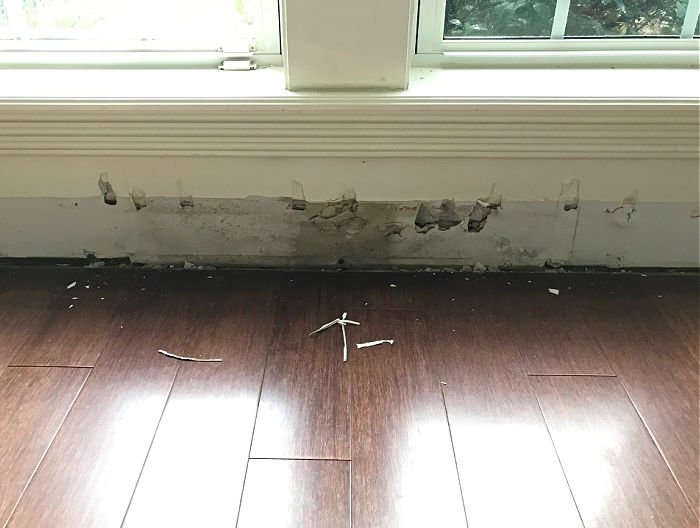
How To Prep Your Home For A Hurricane Inside
- Fill the bathtubs with water. This will give you water for flushing the toilet and some washing.
- Fill empty bottles or clean containers with fresh drinking water.
- Keep 1 days worth of water, food, an emergency radio, light, and blankets in your safest spot during a Tornado. Tornados often happen when a hurricane is moving through an area.
- Your cell phone(s) will be very important. You’ll typically be able to make calls and check the internet for info, as needed. Cell service usually keeps working, even if power goes out. So, get back up phone chargers to last a few days. Try to save those batteries and stretch them out. This USB charger works for phones and other USB devices.
- Emergency Radios are awesome. Having music or news when you’ve lost power is incredibly helpful at providing info and a bit of entertainment. Most emergency radios include lights and sometimes cell chargers too. Be sure to stock up on batteries.
- LED lanterns with Lumens of 500 or higher are great for lighting up dark rooms. Some of these LED lanterns can be phone chargers too.
- Turn the fridge and freezer to it’s coldest setting, in case you lose power. This will help the food stay cold longer.
- Freeze water in plastic containers. You can use these ice blocks to help keep the fridge and freezer cold for some extra time, if power goes out. That water can be used for cooking and drinking once it melts.
- Pack important documents and papers in a watertight container.
- Photograph all household belongings. Get a picture of all appliances, electronics, artwork, furniture, etc. You’ll want proof for any necessary insurance claims and it will help you make an inventory, if necessary.
- Wash all of your clothing. It may be a week or more without laundry, in the worst case scenario. You’ll want clean laundry ready for long power outage or evacuation.
- Pack an evacuation bag with clothing, food, and drink for everyone. Keep medicine and important documents ready to go too. Have a printed evacuation route map ready, just in case the internet is down.
Checking your House for Damage After a Hurricane
If you have Flood Damage, read these guidelines for dealing with insurance companies, safely cleaning the damage, and how to salvage your belongings (including photos, furniture, and clothes).
For additional info and resources, check this Red Cross Hurricane Guide.
Related Posts
- Supplies & Food To Stock Up On Before A Hurricane
- How to Clean Up Your Home After Flood Damage
- How to Store Water for an Emergency – Long Term
- Can You Paint Over Water Stains On Ceiling? Probably
- How to Remove Water Stain from Ceiling Without Paint
- Can You Paint Over Water Stains On Ceiling? Probably
- How to Cut Drywall & Hang Drywall – 15 Beginner Tips
Where Is The Best Place To Stay Inside Your Home During A Hurricane?
The safest place to be in a home or building during a hurricane is in a windowless room. Preferably one in the center of the home or building.
So, sometimes that’s a room under the stairs, an interior hallway, a bathroom without windows, or large closet. The ground floor of the home is generally safer than upper floors during a Hurricane.
Do not shelter in your attic! No one will know you are there. And rescue workers will have a very hard time getting you out.
If flood waters are rising around your house, rescue workers recommend going on your roof so that the rescuers can see you.
If you do have to go to the attic, take an ax or battery operated saw so that you can cut an escape route out.
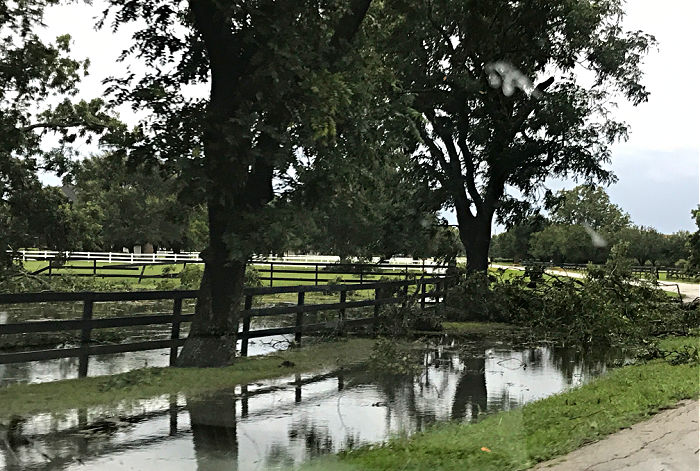
More Tips To Prepare Your Home For A Hurricane
- Keep phones plugged in as much as possible during a power outage. Our power went on and off quiet a bit. Making sure the phone is always plugged in helps you get any charging possible while the power is on.
- Washing dishes uses precious water. I recommend using one pan or kettle for just heating water. Then cook, when necessary, in another pan. And, if water is an issue, wipe pans and pots clean with paper towels before washing with as little water as possible.
- My super cheap Grandpa saved water by keeping a sink full of soapy water all day. If you need to wash your hands, just dip your hands in, scrub them together, then dry off. This works great when you have to conserve water too. Get off grease and dirt with towels or wipes first, to make that water last longer.
- Keep yourself and the kids busy. Turn on the radio to fill the room with normal sounds. Read books, do puzzles, color, craft, sew, knit, clean, organize. Plan to be bored and figure out what your family would like to do in that time. Some friends with power did a lot of baking to stay busy with the kids during the 3 days of rain. I actually finished building and painting a table on our worst day with Hurricane Harvey. And, I had so much time, I also organized our messy office and kids toys. You can actually get a lot done without power.
- Look up at the ceiling in your house a few times a day. Walk the house and check the ceiling of each room and closets for water damage. Check the windows and doors too. Hard winds can blow water under doors. Water was even blown into our closed garage. You want to catch that as soon as possible.
- Look down too. Check baseboards for changes. Almost a week after Harvey ended, I noticed a baseboard under a window had a new 3′ long crack in the caulk. The next day the laminate hardwood floor looked wet and bubbly. That’s how long it took for the water damage to show up. The rain water entered through a weep hole that didn’t have enough clearance. So, keep an eye out for changes.
- Never leave candles burning. Stay safe when you use them. Keep them away from kids, pets, and flammable items. Never fall asleep with candles still lit. Only use lanterns or flashlights while sleeping.
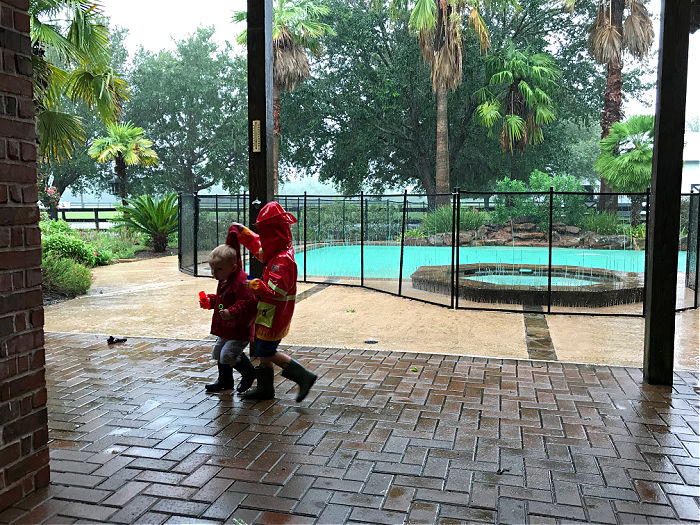
Tips For Staying Safe Near Flooded Roads and Buildings
- Never drive through water on flooded streets. It can be a lot deeper than it looks and flowing water can sweep cars away.
- Never drive on washed out roads or bridges.
- Silt and mud from flooding can be hiding broken glass, nails, and other sharp objects. Try not to drive on it.
- Only walk on silt and mud in safety boots. My husband was wearing thick rubber boots in a home clean up after flooding during Hurricane Harvey and still got a nail through his foot.
- Following that, beware of skin infections and flesh-eating bacteria after entering deep rain water and flooding. The infection can easily enter through cuts and even small bug bites. Read these symptoms for flesh-eating bacteria from WebMD. If you have swelling it can be life threatening and can quickly turn into sepsis. Please, be careful and pay attention to wounds.
- Stay out of buildings with water in them. Electric shock and gas leaks are a risk.
- Also, stay away from down and loose power lines.
- Inspect homes for structural damage before entering.
- See my guidelines for Cleaning Up Flood Damage for more tips and details on safety.
Tips For Safe Evacuation From a Hurricane
If you decide to evacuate your home before a hurricane, unplug all appliance and electronics. And, turn off gas, water, and electric, if possible. This will help prevent possible flooding and fire damage if the home is damaged during the storm.
Take all of your important documents and paper with you. If you prepared before the storm, you should have had these in a waterproof container in an emergency evacuation bag.
Also, take enough food, drink, and gas to last 3 days for each person in the car. Grab all of your medications, even OTC medications too.
People can get stuck in their cars for long periods during last-minute evacuations.
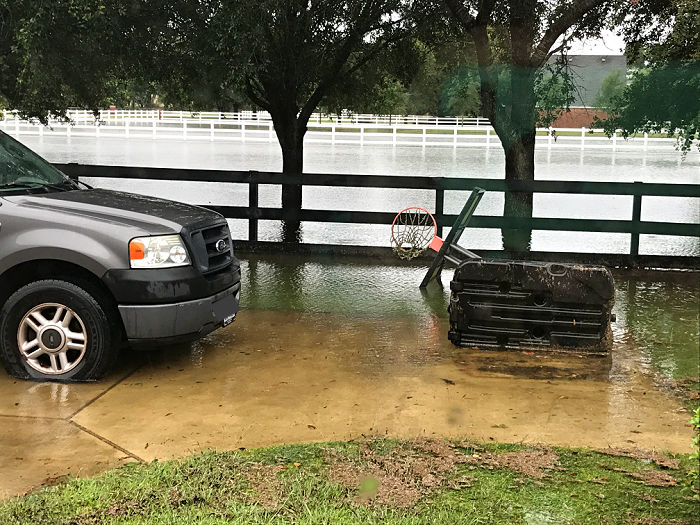
How Far Should You Evacuate From A Hurricane?
If you decide to evacuate before a hurricane, you’ll generally hear that you need to evacuate 50 to 200 miles away from the coastline when a hurricane is approaching.
The exact distance will vary for different cities for a variety of reasons.
It’s important to listen to the local news before a hurricane for the latest recommendations from the Emergency Managers and other government agencies in your city.
You can check the Ready.gov recommendations for emergency evacuations for more info.
If you have been ordered to evacuate, please do so as soon as possible to avoid traffic. Safety is the priority.
Make a Hurricane Evacuation Plan For Your Family
Plan and go over your evacuation route with your family. Most cities near a coast will have marked hurricane evacuation routes. But, really, you’ll generally have a 3 to 5 days warning before a hurricane hits.
So as long as you leave a few days before the Hurricane hits your area, the normal roads inland should be open.
BUT, if the rain has already started to hit the area, the marked evacuation route is probably the safest way to avoid flooded roads. Never drive through flooded roads.
Where Can You Evacuate To During a Hurricane
If you decide you need to leave your home, there are really 3 main options for places to stay during a hurricane; emergency shelters, nearby family or friends, and hotels outside of the hurricane zone.
The Red Cross, your local Emergency Manager, and local news stations should all have a list of emergency hurricane shelters available in your area.
If you can’t stay with nearby family and friends during an evacuation, you really need to go far enough away to have enough hotel rooms to accommodate large amounts of evacuees.
If we ever decided to evacuate during a hurricane in Houston, we’d probably go to San Antonio or Austin. Both of those cities have a large amount of hotel rooms to handle evacuees.
And, they should be far enough away to avoid any problems like power outages or strong winds. One last tip, if you’ll be evacuating with pets, make sure to find a pet-friendly shelter or hotel.
Grab the 16 page free printable version of these tips to prep your home for a hurricane. This printable also includes my list of food and supplies to stock up on before a hurricane.
That’s all of the tips I have to prepare your house for a hurricane. Here’s some more popular DIY posts you might like.
More DIY Projects for Home Owners
Check out How to Caulk A Kitchen Counter – Quick Steps & Video.
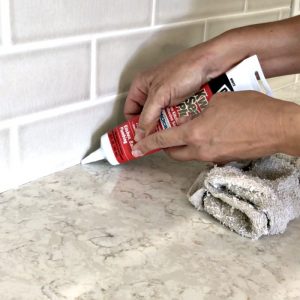
Or this post on Do you use Caulk or Wood Filler on Wood Trim?

This post on Does Grout Renew Work? My Before And After Review is always popular.

And, this post on Best Way To Deep Clean Car Seats is too. I also recommend What Can I Use In Bissell Spot Cleaner?
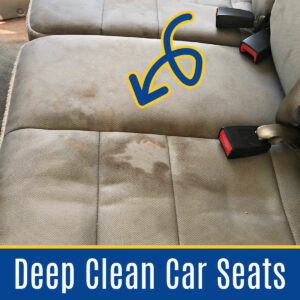
And, last but not least, this post on the Best AC Filter Replacement for Cleaner Air in a Home.

Feeling inspired? That’s it for how to Prep Your Home For a Hurricane, Inside and Outside. Let me know if you have questions.
Don’t forget to sign up for the Abbotts At Home email newsletter to get DIY, Remodeling, and Crafty ideas in your inbox.

Stephanie Abbott has been remodeling homes, updating & building furniture, and working on DIY home maintenance and cleaning tips for over 20 years. Her remodeling has been featured in Better Homes and Gardens Magazine. And, her DIY YouTube channel has had more than 8 million views.
Most of the DIY tutorials and videos on this site focus on beginner to intermediate level DIY Projects that can be done in an affordable way without high-end, expensive tools. All of the cleaning tips on this website have been tested in her home.

